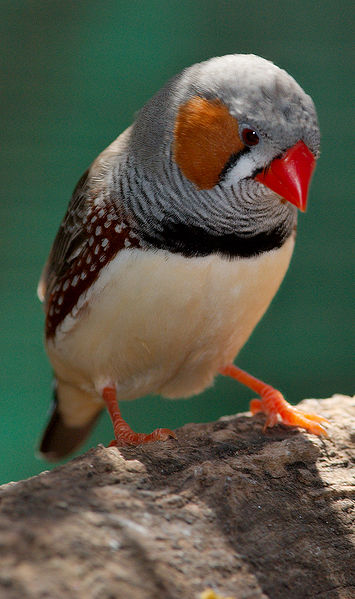 Cowbirds, cuckoos and whydahs are well known brood parasites, meaning that females deposit eggs in the nests of other bird species and leave them to the care of their unsuspecting foster parents. Finch owners may be surprised to learn that some female Zebra Finches also use this reproductive strategy – but with a special twist.
Cowbirds, cuckoos and whydahs are well known brood parasites, meaning that females deposit eggs in the nests of other bird species and leave them to the care of their unsuspecting foster parents. Finch owners may be surprised to learn that some female Zebra Finches also use this reproductive strategy – but with a special twist.
Cheating…Zebra Finch Style
Researchers at Bavaria’s Max Planck Institute for Ornithology (the former stomping grounds of the legendary animal behaviorist Konrad Lorenz) have discovered that certain female Zebra Finches specialize in taking advantage of their neighbors’ nests.
Unlike cuckoos and other brood parasites, which lay eggs in the nests of unrelated birds (please see photo of a Reed Warbler feeding a Cuckoo chick), Zebra Finch females parasitize their own species. Also unique is the fact that, in addition to the foster eggs, the “cheating” Zebra Finch moms also raise a separate clutch of eggs themselves (cowbirds and others typically raise no eggs of their own).
Stealth Required
 Utilizing genetic techniques, the ornithologists at Max Planck were able to determine that 1 in 5 Zebra Finch nests contained eggs that were not produced by the female sitting on the nest.
Utilizing genetic techniques, the ornithologists at Max Planck were able to determine that 1 in 5 Zebra Finch nests contained eggs that were not produced by the female sitting on the nest.
Only a small number of females resorted to parasitism, but they seem to be very skilled at it. Females seeking to use another’s nest must watch their victims carefully – if they lay before the foster female does, she will abandon the nest; wait too long, however, and the foster female will begin incubating her own eggs and leave little opportunity for additions to the clutch. Most parasitic females laid their eggs after the first or second egg was produced by the foster mom.
Evolution in Progress?
We may be seeing evolution at work – female finches that dole out their eggs wind up producing the same number of fledglings (in their own and foster nests) as do females that reproduce in the more usual manner. Depending upon whether or not this trend continues or changes, brood parasitism may become the norm for Zebra Finches, or it may disappear altogether.
Further Reading
The Zebra Finch has been dubbed the “Lab Mouse of the Bird World”; read more about its important contributions in The Unknown Side of the Zebra Finch.
Pin Tailed Whydahs as brood parasites in Uganda.
Male Zebra Finch image referenced from wikipedia and originally posted by Peripitus
Warbler feeding cuckoo image referenced from wikipedia and originally posted by H Olsen
 That Bird Blog – Bird Care and History for Pet Birds
That Bird Blog – Bird Care and History for Pet Birds




One comment
Pingback: Crafty Brood Parasites – Some Zebra Finches Lay Eggs in Neighbors’ Nests